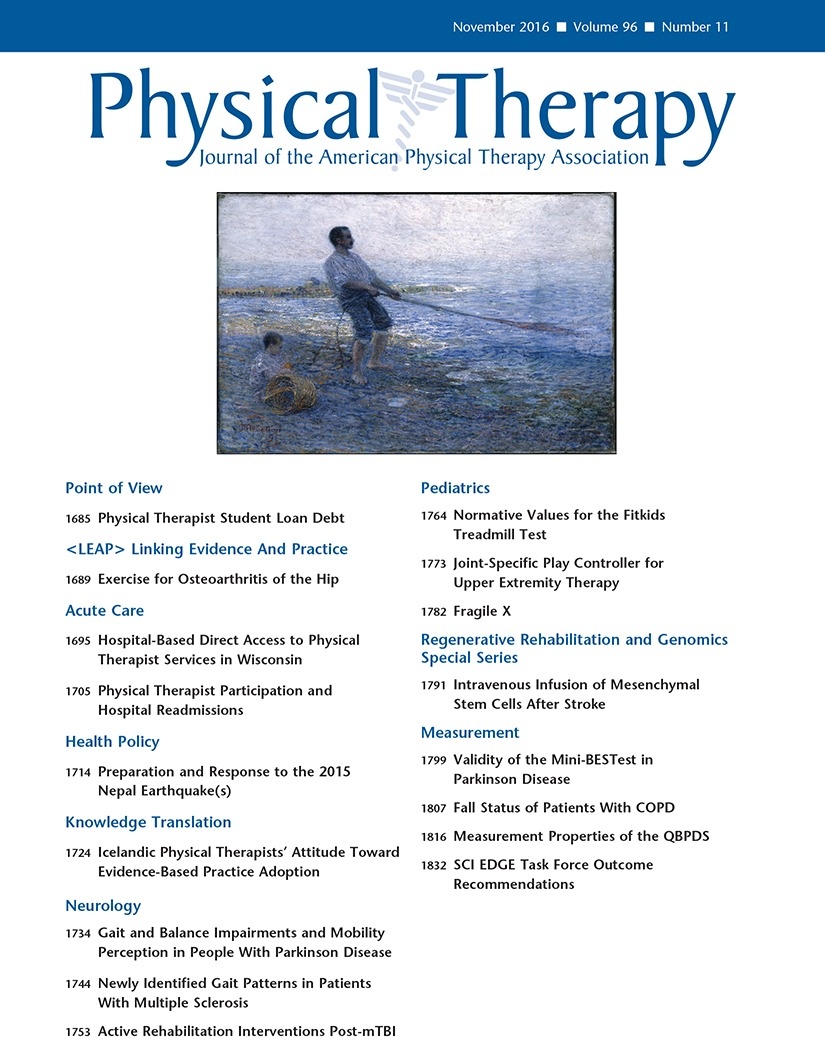
Moderate quality evidence supports strengthening exercises for neck pain in office workers

Moderate quality evidence supports strengthening exercises for neck pain in office workers
Workplace-Based Interventions for Neck Pain in Office Workers: Systematic Review and Meta-Analysis
Phys Ther. 2018 Jan 1;98(1):40-62Did you know you're eligible to earn 0.5 CME credits for reading this report? Click Here
Synopsis
27 randomized controlled trials were included in this systematic review and meta-analysis on workplace-based neck and shoulder strengthening intervention, general fitness training, and ergonomic approach interventions, and their effect on either reducing neck pain among symptomatic office workers, or preventing the development of neck pain in general among office workers. Among office workers with neck pain, there was moderate-quality evidence in support of either workplace-based neck and shoulder strengthening intervention or general fitness training for greater pain reduction than no training. A single study suggested a therapeutic effect of ergonomic adjustment for neck pain, though no significant preventative effect of ergonomic adjustment for neck pain among general office workers.
Were the search methods used to find evidence (original research) on the primary question or questions stated?
Was the search for evidence reasonably comprehensive?
Were the criteria used for deciding which studies to include in the overview reported?
Was the bias in the selection of studies avoided?
Were the criteria used for assessing the validity of the included studies reported?
Was the validity of all of the studies referred to in the text assessed with use of appropriate criteria (either in selecting the studies for inclusion or in analyzing the studies that were cited)?
Were the methods used to combine the findings of the relevant studies (to reach a conclusion) reported?
Were the findings of the relevant studies combined appropriately relative to the primary question that the overview addresses?
Were the conclusions made by the author or authors supported by the data and or analysis reported in the overview?
How would you rate the scientific quality of this evidence?
Yes = 1
Uncertain = 0.5
Not Relevant = 0
No = 0
The Reporting Criteria Assessment evaluates the transparency with which authors report the methodological and trial characteristics of the trial within the publication. The assessment is divided into five categories which are presented below.
4/4
Introduction
4/4
Accessing Data
3/4
Analysing Data
3/4
Results
4/4
Discussion
Detsky AS, Naylor CD, O'Rourke K, McGeer AJ, L'Abbé KA. J Clin Epidemiol. 1992;45:255-65
The Fragility Index is a tool that aids in the interpretation of significant findings, providing a measure of strength for a result. The Fragility Index represents the number of consecutive events that need to be added to a dichotomous outcome to make the finding no longer significant. A small number represents a weaker finding and a large number represents a stronger finding.
Why was this study needed now?
While previous reviews have been performed on workplace-based interventions for neck pain, none have evaluated efficacy specifically among office workers.
What was the principal research question?
Among office workers with neck pain, what is the effect of workplace-based interventions on prevention of neck pain, and what is the efficacy of workplace-based interventions for treatment of neck pain?
What were the important findings?
- Workplace neck and shoulder strengthening exercises demonstrated significantly greater pain reduction compared to no training among office workers with symptomatic neck pain (5 studies; SMD 0.59 [95%CI 0.29-0.89]; GRADE: moderate).
- Group-based neck and shoulder strengthening exercises did not demonstrate a significant difference in pain reduction to physiotherapy in office workers with symptomatic neck pain (1 study; SMD 0.04 [95%CI -0.76, 0.84]; GRADE: moderate).
- General workplace fitness for 1 hour per week demonstrated significantly greater pain reduction compared to no training among office workers with symptomatic neck pain (2 studies; SMD 0.43 [95%CI 0.08-0.78]; GRADE: moderate).
- Multiple work station adjustments demonstrated significantly greater reduction in pain when compared to no intervention in office workers with symptomatic neck pain (1 study; p<0.0001; GRADE: very low).
- Intervention of an alternative mouse and arm support did not significantly reduce the incidence of neck pain compared to no intervention in a general office worker population (2 studies; RR 1.60 [95%CI 0.99-2.60]; GRADE: low).
What should I remember most?
Among office workers with neck pain, there was moderate-quality evidence in support of either workplace-based neck and shoulder strengthening intervention or general fitness training for greater pain reduction than no training. Workplace-based neck and shoulder strengthening exercises also demonstrated similar pain reduction to individualized physiotherapy. One study suggested a therapeutic effect of ergonomic adjustment for neck pain, though statistically significant prevention of neck pain among office workers in general was not established in a pooled analysis.
How will this affect the care of my patients?
The results of this study appear to support workplace-based neck and shoulder strengthening intervention or general fitness training as effective interventions for reducing neck pain among office workers. The evidence on the effect of ergonomic alterations as either a therapeutic option or preventative option for neck pain was limited, and of generally low quality. Additional work in these areas should be considered.
Learn about our AI Driven
High Impact Search Feature
Our AI driven High Impact metric calculates the impact an article will have by considering both the publishing journal and the content of the article itself. Built using the latest advances in natural language processing, OE High Impact predicts an article’s future number of citations better than impact factor alone.
Continue



 LOGIN
LOGIN

Join the Conversation
Please Login or Join to leave comments.
Orthopaedic Surgeon - Canada
Maintien de la condition physique